Indoor Plant Seed Planting: Essential Guide
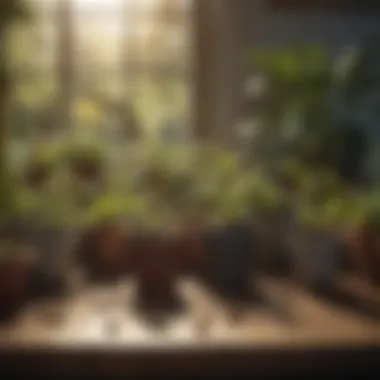
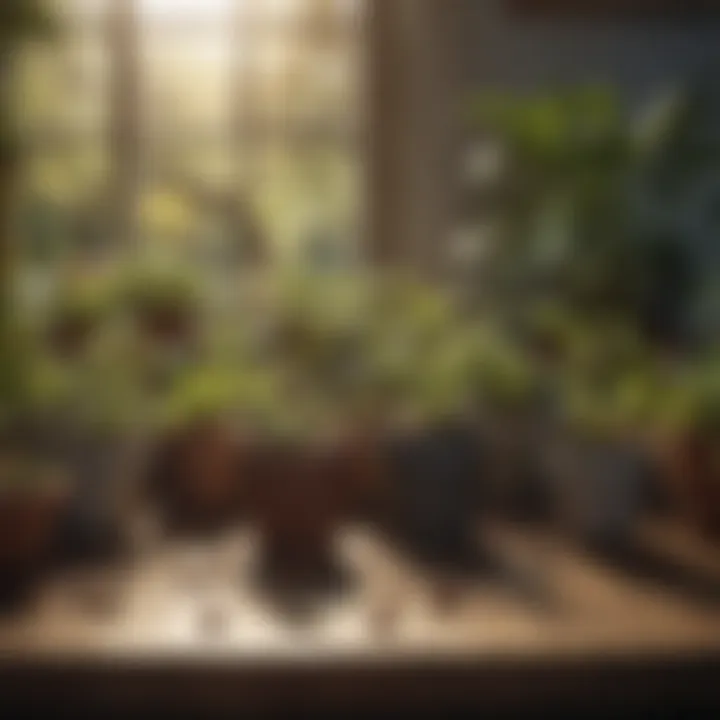
Intro
Creating an inviting indoor space often revolves around greenery. Indoor plants not only beautify your living area but also enhance air quality and promote a sense of well-being. In this section, we’ll delve into the essential factors to consider when planting seeds for indoor plants. The journey starts with understanding the environment you can provide, along with the types of seeds that flourish indoors.
As a housewife or homeowner, you might want to turn your home into a green sanctuary. Committing to indoor gardening involves more than just sporadically watering plants. It’s about crafting an ecosystem where your plants can thrive. This guide provides practical tips and insights into the entire process from seed selection to nurturing those seeds as they mature into beautiful plants.
Whether you're a seasoned green thumb or just dipping your toes into gardening, knowing how to effectively plant seeds can open the door to unlocking beautiful indoor greenery.
Trending Styles
Modern Minimalism
Modern minimalism in indoor gardening embraces clean lines and simplicity. This style is characterized by a few selected plants that echo the principles of simplicity and space efficiency. Common choices include snake plants or peace lilies, which thrive in low light and require minimal maintenance. Consider using sleek white pots that complement the overall decor. This can make a significant diffence when you want to achieve a serene indoor atmosphere.
Tips for Modern Minimalism:
- Choose few varieties of plants to avoid clutter.
- Opt for monochromatic pot colors that blend in with your home décor.
- Place plants in strategic locations, like entryways or corners, to enhance structure.
Cozy Rustic
For those who like their space to feel warm and inviting, the cozy rustic style is ideal. Here, plants are mixed with natural materials such as wood, clay, or even woven baskets. This style encourages a vibrant selection of plants, with some blooming flowers, ferns, and trailing vines to create a feeling of being outdoors.
This style caters well to pots with earthy tones and textures, making it feel like a garden right inside your home.
Tips for Cozy Rustic:
- Use terracotta pots or wooden containers.
- Incorporate natural elements such as stones or branches.
- Hang plants at different heights to create depth and interest.
Color Palettes
Calming Neutrals
A soothing palette of neutrals can create a peaceful setting, allowing greenery to take center stage. Shades of beige, taupe, and soft grays are perfect backgrounds for the vivid greens of your plants. Using such colors can contribute to a tranquil atmosphere, promoting relaxation.
Bold Accents
If your taste skews bolder, consider using rich colors like deep navy, forest green, or terracotta. These colors can create a stunning contrast against the green, drawing the eye to your plants. Minimal yet impactful, this color palette complements bold plant features, especially those with unique leaves or striking shapes.
"When arranging plants, remember that colors can either harmonize or contrast with your space, so choose wisely to create the desired effect."
Indoor gardening is an art form that balances aesthetics with care for living plants. With this guide, you'll gain the knowledge to thoughtfully approach planting seeds and incorporating greenery into your indoor lifestyle.
Prelims to Indoor Seed Planting
Planting seeds for indoor plants is more than just a hobby; it’s a doorway to breathing life into our homes. With numerous benefits, the practice enriches our living spaces while offering a unique connection with nature. Indoor gardening is not simply about aesthetics; it's about cultivating a healthier environment and nurturing our mental well-being. As we embark on this journey, understanding why indoor plants hold such importance in our lives can deepen our appreciation for these green companions.
The Importance of Indoor Plants
Indoor plants are vital for various reasons, shaping both the physical and emotional landscapes of our homes. They purify the air—removing harmful toxins and releasing oxygen, creating a fresher atmosphere. In a world where we spend significant time indoors, that clean air can make all the difference.
Moreover, indoor gardening can serve as a form of therapy. Tending to plants has been linked to reduced stress and improved mood, acting as a soothing balm for the mind. There’s a profound sense of satisfaction in watching seeds sprout and become thriving plants, which reflects on our overall mental health and happiness.
Plants are not just decorations; they are life-enhancing elements that contribute to a better quality of living.
Beyond the personal benefits, cultivating indoor plants can foster sustainability. By growing your own plants, you reduce your carbon footprint and promote a more eco-friendly lifestyle. The act itself encourages mindfulness and responsibility towards the environment, embodying the idea of sustainability.
Benefits of Growing from Seeds
Starting plants from seeds offers several clear advantages that seasoned and novice gardeners alike can appreciate. One prominent benefit is the sheer variety of plants available at your fingertips. When you grow from seeds, you’re not limited by the typical selections of local nurseries. Think of all the exciting, unusual varieties you can introduce to your home!
Growing from seeds can also be more economical than purchasing established plants. A packet of seeds usually costs much less than even one mature plant. Plus, you can nurture multiple seedlings at once, potentially expanding your indoor greenery without breaking the bank.
Another significant advantage is the level of control it gives you over growing conditions. Seeds allow you to decide the soil type, pot size, and watering regimen from the start. This means you can tailor the growth environment to the specific needs of the plant, increasing the chances of successful growth.
Finally, there’s something deeply gratifying about beginning the planting journey from seed. Each seed typically requires careful attention and a unique approach to thriving. By investing time and effort right from the start, you develop not only a deeper bond with your plants but also gain invaluable gardening experience, enriching the overall process of indoor gardening.
Choosing the Right Seeds
Choosing the right seeds is like laying the foundation for a house. It sets the tone for everything that follows in your indoor gardening journey. If you pick seeds that are ill-suited for your conditions, you're likely to face an uphill battle. That’s why understanding the different types of seeds and the considerations in selecting them is essential for success in indoor gardening.
Types of Seeds Suitable for Indoor Growth
When it comes to seeds, not all are created equal — especially for indoor planting. Here are a few categorizations that can help you slice through the confusion:
- Herb seeds: Think of basil, mint, or parsley. These not only flourish indoors due to their compact size but also bring fresh flavors to your kitchen.
- Vegetable seeds: Look towards varieties like dwarf tomatoes and salad greens. They adapt well to limited space and brighten up your garden.
- Flower seeds: Consider options like pansies or marigolds. They beautify your living space while being relatively easy to maintain.
Each of these types offers unique advantages that make them suitable for indoor growth. The key is understanding your available space, light, and moisture levels.
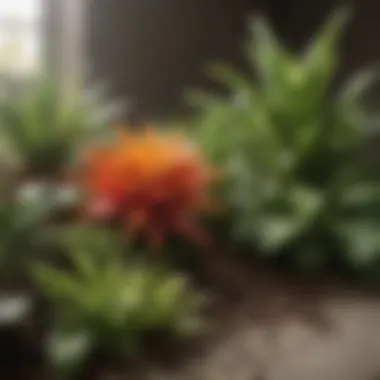
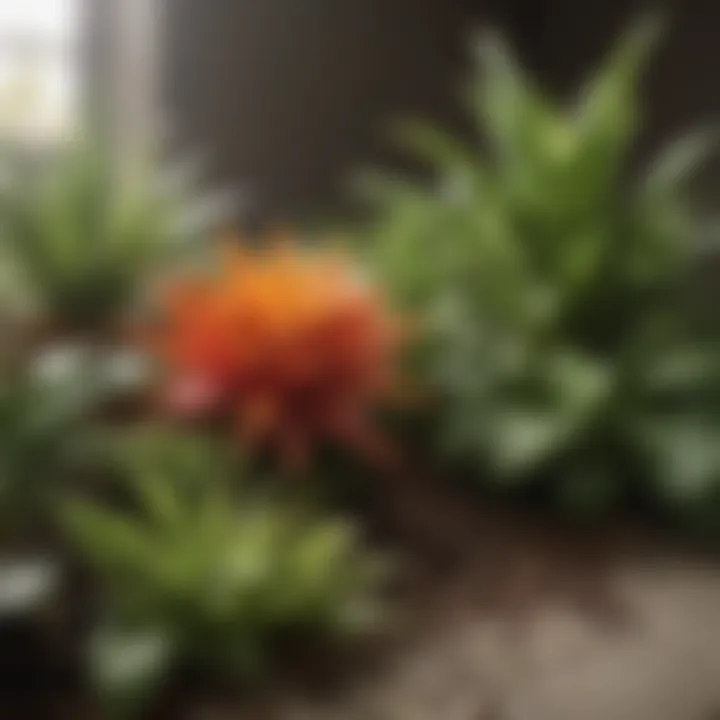
Considerations When Selecting Seeds
Before jumping into the world of options, a few considerations can make the difference between a thriving garden and one that struggles along. Each consideration caters to a specific aspect that resonates with the success of your indoor gardening.
Genetic Variety
Genetic variety encompasses a range of factors influencing plant adaptability and resilience. Choosing seeds with diverse genetic backgrounds means you’re likely to get plants that can handle varying conditions. This is essential since indoor environments can fluctuate in temperature and humidity. Not to mention, you can enjoy a broader range of flavors or colors in your plants. For instance, heirloom tomato seeds often have a richer flavor profile compared to their hybrid counterparts. However, do keep in mind that some genetically diverse plants may require particular care.
Germination Time
Germination time determines how quickly your seeds will sprout, influencing your overall gardening timeline. Fast-germinating seeds, like radishes, can provide a quicker return on your efforts, gratifying gardeners with quick results. Conversely, slower germination can lead to deeper-rooted plants, but will require patience. Be mindful that the germination period can heavily depend on temperature and moisture conditions. You wouldn’t want to start a long-term project if you’re pressed for time or expecting immediate gratification.
Size of the Plant
The size of the plant when fully grown is crucial for indoor settings. Compact or dwarf varieties thrive better in likely constrained spaces. Lettuce and dwarf sunflowers are examples of plants that fit into tight corners and still manage to deliver impressive aesthetics and functionality. Large plants like a big tomato bush might lead to overcrowding, which hampers growth. It's about understanding not just the current size, but how it will interact with your available space as it matures.
"Selecting the right seeds is the first step towards a flourishing indoor garden. It's about aligning expectations with the conditions you can provide."
Preparing for Planting
Preparation is a crucial phase in the journey of planting seeds for indoor plants. It sets the stage for successful growth and can mean the difference between a thriving indoor garden and a disappointing one. Choosing the right containers and creating an optimal soil mixture are fundamental steps that directly impact the health of your future plants.
Selecting the Right Containers
When it comes to containers, the selection is not just about aesthetics; it's about functionality. The right containers provide essential drainage, promote adequate air circulation, and ensure that the roots have plenty of room to grow. Materials such as plastic, clay, and ceramic have their pros and cons.
- Plastic Containers: Lightweight and available in various shapes and sizes, plastic pots retain moisture better but can overheat if left in direct sunlight.
- Clay Pots: These are great for drainage but can dry out quickly, so frequent watering is essential. They also tend to be more durable.
- Ceramic Containers: They add elegance to your decor but can be heavy and pricey. Also, ensure they come with drainage holes, or else you risk overwatering your plants.
Ultimately, it's best to match the container size with the expected growth of the plant. A common mistake is choosing a pot too large, which can lead to excess soil moisture around the roots.
Creating an Optimal Soil Mixture
The soil is the lifeblood of your indoor plants. Not just any soil will do. Understanding how to create an optimal soil mixture is vital for your plants' growth, providing them with the necessary nutrition, drainage, and structure.
Components of Potting Soil
Potting soil is likely the best base for your indoor gardening endeavors. A well-crafted potting mix is lightweight and promotes good drainage while retaining moisture—exactly what you want for seed germination. Here are the essential components:
- Peat Moss: This organic material retains moisture and provides necessary nutrients. It is a popular choice for many indoor gardeners.
- Perlite or Vermiculite: These are minerals that help with aeration and drainage. Perlite adds porosity, while vermiculite retains more moisture.
- Compost: Adding some compost enriches the soil, allowing beneficial microbes to flourish and enhance nutrient delivery to your plants.
Each of these ingredients adds a unique edge to the potting soil, helping balance water retention and drainage. Depending on what you intend to grow, you may tweak these components for an even better blend!
Soil pH Considerations
Soil pH is an essential aspect that often gets overlooked but plays a significant role in indoor gardening. The pH scale ranges from 0 to 14, with 7 being neutral. Most indoor plants prefer a slightly acidic to neutral pH, around 6 to 7. Why does this matter?
- Nutrient Availability: The pH level can affect how well certain nutrients are absorbed by the plants. For instance, iron is more available at lower pH levels.
- Plant Health: A pH that's too high or too low can lead to nutrient deficiencies, stunted growth, or even plant death.
Testing your soil's pH can guide you in making necessary adjustments, like adding lime to raise the pH or sulfur to lower it, allowing you to cultivate a healthy indoor garden with thriving plants.
Key Takeaway: Spending time on the right containers and soil mixture will pay off in the long run. Proper preparation fosters a nurturing environment for seeds to germinate and grow strong, setting the foundation for a flourishing indoor garden.
Planting Techniques
Planting techniques are crucial for anyone looking to start or enhance their indoor garden. A good technique sets the stage for seed germination and healthy growth. Without proper practices, even the best seeds can struggle to establish themselves. So, let’s break down some important elements that contribute to successful planting, emphasizing the step-by-step process and proper arrangements.
Step-by-Step Planting Process
Seed Depth Guidelines
Determining the right seed depth is one of those pivotal aspects! It varies depending on the type of seed you’re dealing with. Some seeds need to be barely covered, while others prefer to burrow deeper into the soil. The general guideline states that seeds should be planted about two to three times their diameter in depth. However, this might change based on the species.
The key characteristic of seed depth guidelines is that they directly influence seedling emergence. For instance, seeds planted too deep may struggle against the soil’s resistance, leading to poor germination rates. In this article, we advocate for this aspect because it not just affects growth speed but also overall plant health. Having a proper depth can often determine whether your seeds flourish or flop.
The unique feature here is recognizing that certain curious varieties like the lettuce seeds actually thrive when they are just sprinkled on top! They require light exposure instead of being buried. Thus, improper placement can inhibit the light they need, so keeping this in mind adds a layer of understanding for gardeners.
Watering Procedures
Next up on our checklist is watering methods. Watering is far from a mere afterthought; it's a fundamental part of the planting process. On the one hand, seeds require moisture to germinate. On the other hand, overwatering can create a soggy mess that suffocates young roots. It’s a balancing act; consistent monitoring is essential.
A major point here is ensuring even saturation of soil, avoiding extremes like dry patches or oversaturated zones. An easy recommendation is to check the surface of the soil—if it feels dry to the touch, it likely needs a drink.
What’s fascinating about watering procedures is that they are adaptable. Techniques range from gentle misting to heavier pouring, each with its nuances. For instance, using a watering can with narrow spouts can help target specific areas, providing controlled moisture to delicate seedlings.
Nevertheless, if you’re using a method that causes excess runoff, you might find yourself wrestling with root rot down the line. So, while the advantages include better control over watering, being aware of the potential pitfalls is crucial.
Proper Spacing and Arrangement
Considering proper spacing and arrangement is akin to creating that perfect seating for a dinner party—it may seem trivial, yet it dramatically affects the overall ambiance. Indoor plants need their space to grow properly without competing for resources. When seedlings are too close together, their leaves may tangle, stifling airflow and inviting disease.


A good rule of thumb is to give plants about six inches apart for smaller varieties like basil, while larger plants like tomatoes may call for a foot or more. This gives each plant room to breathe!
"The best gardening is about paying attention to the natural rhythms and needs of your plants. "
Lighting Conditions for Indoor Plants
Understanding the right lighting conditions is crucial for the success of indoor gardening. Light acts as the lifeblood for your plants, playing a pivotal role in the process of photosynthesis, which in turn affects growth, flowering, and overall health. The quality and quantity of light can influence plant behavior, leading to lush foliage or, on the flip side, weak and spindly growth. It’s not just about having the most light; it’s about having the right type and amount for the particular plants you're growing.
Natural Light Versus Artificial Light
When it comes to lighting, there are two primary sources: natural and artificial. Natural light, which comes from the sun, varies in intensity and duration throughout the day and across seasons. Many gardening aficionados often prefer it because it is free and tends to provide a broad spectrum of light that plants can absorb. However, not all homes receive ample sunshine, leaving some plants craving more light than what’s available.
On the flip side is artificial light, which can be tailored to meet specific needs. Grow lights, such as LED and fluorescent options, allow you to regulate the duration and intensity of light to mimic the natural environment. Though using these can often be an upfront investment, it's worth considering if you want your indoor plants to thrive free from natural light limitations.
Understanding Light Requirements for Different Species
Every plant has its own light preferences, whether that’s basking in bright sunshine or being content in a dim corner.
Low-Light Tolerance Plants
Low-light tolerance plants are like that friend who can easily adapt to any party setting. They don’t need a raucous gathering to thrive. These species, such as Pothos and Snake Plant, are often popular choices for indoor gardens. The key characteristic here is their ability to photosynthesize efficiently, even in subdued lighting.
A unique feature of low-light tolerance plants is their slow growth rate. They may not shoot up overnight or bloom exuberantly, but they offer a wonderful opportunity for those who might not have a green thumb. Their ability to survive on less light is a significant advantage for busy households or those in apartments where sun exposure is limited. However, they do still require some care; overwatering and poor soil can cause problems, despite their resilience.
Light-Intensive Species
Now, if you prefer vibrant colors and show-stopping plants, then light-intensive species might be your ticket. These plants, including Orchid and Citrus Trees, require bright and direct light to flourish. Their growth can be vigorous, producing stunning flowers or fruits when given the right conditions.
The remarkable aspect of light-intensive species is the speed at which they grow; with adequate light, you may even witness rapid flowering or fruiting. However, they demand more attention regarding placement. Too little light can result in lackluster performance, while too much direct sunlight may lead to scorched leaves. Therefore, knowing when to offer a bit of shade is essential in maintaining their health.
"The difference between a thriving plant and a lifeless leaf can often be traced back to its lighting conditions."
In summary, whether you're drawn to the adaptability of low-light plants or the vibrant energy of light-loving species, understanding these dynamics is essential for nurturing a successful indoor garden. It's about finding what best suits your living space and lifestyle.
Watering and Humidity Needs
Watering and maintaining proper humidity levels are fundamental to the health of indoor plants, especially seedlings. These elements create the right environment for seeds to thrive and are deeply interconnected. A plant's water intake not only affects its immediate growth but also plays a crucial role in nutrient absorption, photosynthesis, and overall vitality.
Understanding how much water your plants need, when to provide it, and how to monitor humidity can prevent many common gardening pitfalls. Too much or too little water can spell disaster, so let’s break down the best practices.
Best Practices for Watering Indoor Seedlings
Signs of Overwatering
Overwatering is like a slow poison for your plants. It might seem counterintuitive, but giving too much water can harm seedlings as much as thirst can. A key characteristic of overwatered plants is yellowing leaves that feel mushy. If you notice leaves drooping despite ample water, that's a red flag.
In this article, identifying signs of overwatering helps you understand the delicate balance needed in indoor gardening. This issue often arises in the first few weeks after planting.
Unique Feature: One unique feature of overwatering is that it can lead to root rot, which often goes unnoticed until it’s too late. It can feel like you’re trying to save a sinking ship, but that ship has already looked to the bottom of the ocean. The disadvantage is simple—once roots decay, recovery might be nearly impossible unless you act swiftly. Regular checks and maintenance can keep such disasters at bay.
Signs of Underwatering
On the flip side of the coin, underwatering presents its own challenges. Plants that are dehydrated may show crisp edges on leaves and a general limpness. Typically, if you stick your finger in the soil and it feels dry a couple of inches down, your seedlings are crying for a drink.
The signs of underwatering are crucial to recognize since plants rely on moisture to carry out essential functions. This article emphasizes that just like humans, plants can also suffer from dehydration, which significantly causes stress.
Unique Feature: One interesting aspect is that while some plants can tolerate drier conditions, sudden changes can wreak havoc. For example, transitioning from dry soil to waterlogged soil (or vice versa) can shock your plants. The key takeaway here is maintaining a steady hydration schedule, as this promotes deep root systems.
Maintaining Humidity Levels
Humidity is another pivotal component of indoor gardening. The air's moisture needs to strike a harmonious balance; too little can cause seedlings to dry out, while too much can foster fungal diseases. Maintaining humidity levels between 40% and 60% offers an ideal environment for tender seedlings.
Here are some simple ways to manage humidity:
- Using a Humidifier: If air is particularly dry, a room humidifier can work wonders.
- Grouping Plants Together: Plants tend to create a mini ecosystem where moisture can circulate more freely.
- Water Trays: Placing water trays filled with gravel under your plants not only increases humidity but also provides a steady source of moisture.
Remember, monitoring humidity levels is as vital as keeping an eye on watering schedules. Use tools like hygrometers to keep track. Keeping balconies filled with indoor plants might seem like a fun idea, but balancing all these factors will ensure they flourish beautifully.
Nurturing Young Plants
Nurturing young plants is a critical phase in the journey from seed to lush greenery. It’s a delicate balancing act that requires understanding the needs of the plants and providing the right environment. The right care at this stage can spell the difference between a thriving indoor garden and a disappointing array of wilting leaves.
One of the main benefits of nurturing young plants is the development of a strong and healthy root system. This foundation not only supports the plant above ground but also ensures that vital nutrients and water are efficiently absorbed from the soil. Keep in mind, though, that seedlings are typically more vulnerable than mature plants. So, providing appropriate fertilization, transplanting at the right time, and ensuring a consistent watering routine become imperative at this stage.
Fertilization Strategies
Types of Fertilizers
When nurturing young plants, choosing the right type of fertilizer is vital. There are generally two main categories: organic and synthetic fertilizers. Organic fertilizers, such as compost or worm castings, offer slow-release nutrients, which are often more manageable for young plants. They build a rich soil environment, enhancing the overall health of the soil as it breaks down. Synthetic fertilizers, on the other hand, provide quick boosts of nutrients and can be very efficient at times when plants exhibit signs of needing an immediate nutrient kick.
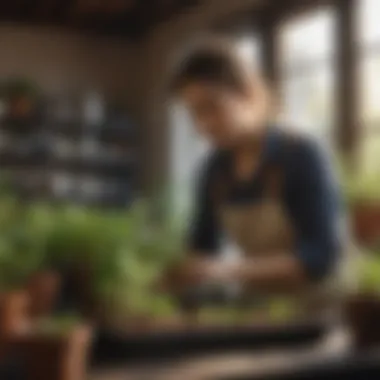
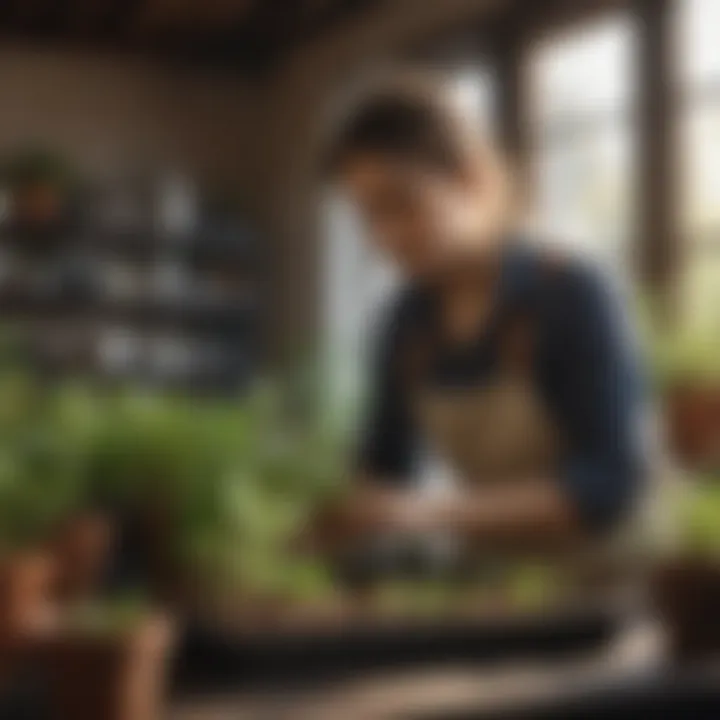
The key characteristic of fertilizers is their N-P-K ratio, which represents the percentage of nitrogen, phosphorus, and potassium. For young plants, a balanced ratio—like 10-10-10—ensures that they receive a well-rounded intake of essential nutrients. However, it's crucial to be aware that too much nitrogen early on can result in lush foliage but weak plants that struggle to grow stronger stems.
Timing of Application
The timing of fertilizer application is just as important as the type selected. For young indoor plants, a common practice is to wait until the seedlings have developed a few sets of true leaves before introducing fertilizers. This is because their root systems are still adapting to their new environment, and premature fertilization could lead to nutrient burn.
Frequent but diluted applications help keep nutrient levels steady. Young plants thrive better with light, consistent feedings rather than heavy doses at longer intervals. This way, you’re not overwhelming them while they get used to their surroundings.
Transplanting Seedlings
When to Transplant
Transplanting is a major milestone in the life of a young plant. Knowing when to make this transition can determine how well the plant adjusts after transplanting. Usually, once seedlings have developed several sets of true leaves and their roots start to fill the container, it's time to consider transplanting.
The key characteristic of this stage is size; a cramped root zone can stunt growth and development, as it limits the available nutrients, water, and air. If you notice roots poking out of the bottom holes of the container, that's a reliable sign. Delaying transplanting can lead to weaker, more stressed plants, less resilient in their next phase of growth.
How to Transplant Effectively
Transplanting requires careful hands and thoughtful preparation. Begin by selecting a new, appropriately sized container—one that allows the roots to expand without overwhelming them. When removing the plant from the pot, try to disturb the roots as little as possible. Easing the plant out gently will help minimize shock.
Ensure the new pot contains a suitable soil mix that retains moisture while draining excess water, preventing root rot. After placing the seedling in its new home, water it thoroughly and place it in a location with ideal light and humidity conditions to help it settle in. Successful transplantation means that your beloved seedling can continue its journey toward becoming a flourishing indoor plant.
Remember: Nurturing young plants is about patience and observation. Each plant has its own character and needs—stay attuned to what they are trying to tell you.
By understanding these nurturing techniques, you can effectively guide your indoor plants through their early stages, ensuring they are healthy and ready to thrive as they grow.
Pest and Disease Management
Pest and disease management is crucial for anyone looking to maintain a thriving indoor garden. These elements can make or break the well-being of your plants. Without effective management, pests can rapidly multiply, leading to stunted growth and even the death of your plants. Therefore, understanding this area ensures that your hard work in seed preparation and nurturing does not go to waste. Having a proactive approach to pest and disease management can save time, money, and emotional energy—an investment that houses quickly turns into flourishing ecosystems.
Identifying Common Pests in Indoor Gardening
Indoor gardens are not immune to pests. Identifying common pests early can make all the difference. Some of the typical culprits include:
- Aphids: Small, soft-bodied insects that suck sap from plants, leading to yellowing leaves.
- Spider Mites: Tiny arachnids that create webs on the underleaf. They thrive in dry conditions.
- Mealybugs: Recognizable by their cotton-like appearance, these suck the juice from plants and can cause significant harm.
- Whiteflies: They appear like small moths and can cause wilting by feeding on sap.
Recognizing these pests at an early stage allows you to take the needed action before they escalate into larger problems.
Preventative Measures and Control Strategies
To ensure your indoor garden stays healthy, it is vital to adopt preventative measures and effective control strategies. Methods can be divided into natural and chemical treatments, each varying in approach and implications.
Natural Pest Control Options
Natural pest control methods have gained traction for their eco-friendliness and lower toxicity. These methods include introducing beneficial insects like ladybugs, which naturally combat pests like aphids.
A standout feature of natural pest control is the minimal impact it has on the indoor ecosystem. It fosters biodiversity in your plants, making them resilient against pests. Most home gardeners favor these methods, especially because they align well with a holistic view of indoor gardening.
However, a potential downside is that results may take time to manifest. While patience is often rewarded, those in a hurry might feel stymied by the slower pace of natural approaches.
Chemical Treatments
Chemical treatments can be effective for a quick resolution, often providing immediate relief if your indoor garden falls victim to pests. These products usually target the pests directly, helping to eradicate them swiftly.
The main characteristic of chemical treatments is their potency, making them a popular choice for those who feel overwhelmed by a sudden infestation. Despite their efficiency, a unique feature to consider is the lingering effects of chemicals on both plants and the surrounding environment. They can sometimes lead to the plant absorbing harmful residues, impacting growth and health.
As convenient as they may be, chemical treatments should be used judiciously. Over-reliance on them can lead to resistant pest populations and might upset the delicate balance of your indoor ecosystem.
"The path to a healthier indoor garden lies within the balance between natural remedies and chemical interventions, hand in hand."
By understanding the characteristics, advantages, and pitfalls of both natural and chemical control strategies, you can tailor your approach to manage pests effectively while nurturing a vibrant indoor garden.
End
Reflecting on the journey through indoor seed planting, it's clear how vital this topic is for anyone aiming to cultivate a thriving indoor garden. Growing plants from seeds isn’t just a hobby; it’s a means of breathing life into your home. Embracing the entire process—from selecting the right seeds to nurturing them into full-grown plants—offers numerous benefits. You’re not just beautifying your living space; you're fostering a sustainable source of fresh herbs, flowers, or even vegetables, which can contribute to a healthier lifestyle.
Moreover, understanding the nuances of each step mentioned can help avoid common pitfalls that other novice gardeners might face. For instance, knowing when to transplant or recognizing the signs of overwatering can make all the difference between a flourishing plant and a withered one. It’s essential to take notes and reflect on the growth process. Each plant interaction teaches valuable lessons that can be applied in future gardening efforts.
"Gardening is a way of showing that you believe in tomorrow."
Thus, this guide not only serves as a comprehensive resource to kickstart or enhance your indoor gardening journey but also emphasizes the satisfaction that comes when you see your seeds sprout into life.
Recap of Key Points
In this guide, we covered a range of fundamental concepts that are essential for successful indoor seed planting:
- Choosing the Right Seeds: We discussed different types of seeds ideal for indoor growth and factors to consider when selecting them.
- Preparing for Planting: The importance of selecting suitable containers and creating the right soil mixture was highlighted.
- Lighting Conditions: Understanding the light requirements specific to various plant species ensures healthy growth.
- Watering and Humidity: Best practices for maintaining moisture levels crucial for young seedlings were presented.
- Nurturing Young Plants: Emphasis on fertilization strategies and timing of transplanting.
- Pest Management: Identifying pests and employing effective control measures was integral to protecting your plants.
Future Considerations for Indoor Gardeners
As you reflect on your indoor gardening experience, consider the following aspects for growth and improvement:
- Continuous Learning: Stay abreast of new indoor gardening techniques and advancements. Knowledge sharing through platforms like Facebook groups or Reddit can offer fresh insights and solutions to challenges.
- Experimenting with Varieties: Don’t shy away from trying new seeds or even unconventional plants. Each experiment expands your gardening skill set.
- Seasonal Adjustments: Be aware of changing seasons and how they can affect your plants. Adjust your care routines accordingly.
- Community Engagement: Engage with local gardening groups or forums. Learning from fellow gardeners can lead to novel approaches and enhance your gardening community.
- Eco-Friendly Practices: Consider integrating sustainable practices into your gardening routine. Reducing chemical usage and opting for organic solutions benefits both your plants and the environment.
As you delve deeper into the world of indoor gardening, remember that it’s a continuous journey of learning, experimentation, and growth. Your indoor plants reflect your dedication and will reward you, not just with beauty but also with a deeper connection to nature.















